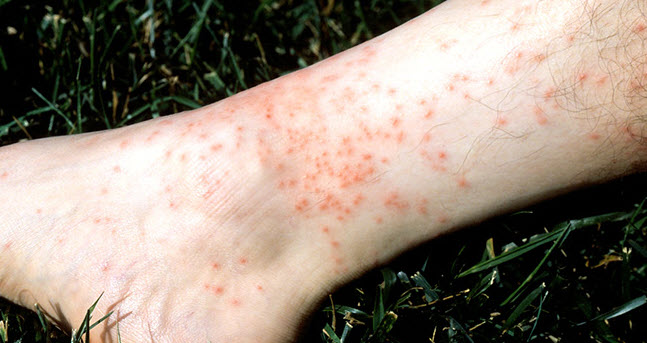Why do no-see-ums bite? Because they can. Actually, no-see-ums bite because they’re programmed that way for survival and reproduction.
You’d think exercise would be a rewarding activity, but if you perspire during your outdoor workout, you’re attracting the attention of a tiny insect that has a powerful bite. “The human skin emits many odors…scientists are still learning which ones attract insects to us,” says biology professional Amanda Williams.
‘Fatal’ Attraction
All of us give off carbon dioxide and heat. When we are outside and exercising, some of us emit a lactic acid. These are aphrodisiacs to mosquitos, bedbugs…and no-see-ums. Another factor as to why we attract no-see-ums seems to be a lack of stress. Mellow people attract more no-see-ums that stressed-out people.
Prevention is Key
Not getting bitten by no-see-ums in the first place is the best way to manage these pesky biters. But it happens to all of us at one time or another: Insane itchiness is the first clue you’ve been bitten by one or more no-see-ums.
Bite Sites
Perspiration points near your neck and ankles (wearing closed shoes with socks) are often the sites of no-see-um bite clusters. You feel itchiness. When you look at the increasingly itchier bite site, you see a tiny red dot. That’s a trademark sign you’ve been bitten by a no-see-um.
What to Do About No-See-Um Bites
The healing process may take 2 weeks. Once you’ve spotted that tiny red dot, take action:
- Look for more bites – No-see-ums travel in groups and each insect bites more than once. Look for red-dot clusters and welts on any exposed skin. The small red dot can expand up to 2″ in diameter and quickly become a raised welt.
- Wash bite areas – As soon as possible, use warm, clean water and antibacterial soap to wash bite areas. Washing helps reduce irritation and infection risk.
- Don’t scratch – That’s easier said than done! Scratching can slow the healing process by re-opening no-see-um welts. In addition to itching for a longer period of time, scratching puts you at risk for infection.
- Keep hands clean – You’re going to scratch; maybe while asleep. Make sure your hands and nails are clean during the time you are nursing no-see-um bites.
Seek Pain Relief from No-See-Um Bites
It’s amazing how painful no-see-um bites are. Use any pain management that provides relief. Ice packs, frozen veggies, or ice cubes wrapped in washcloths can alleviate pain.
For some people, hot water provides pain relief. Heat – don’t boil – water and dip a cotton swab into the water and apply to the no-see-um bite. This will sting at first, but it works.
Always follow package directions when using OTC (over-the-counter) medications:
- Aloe vera ointments and salves can deliver pain relief but use full-strength. For example, your hand lotion “with aloe vera” probably won’t help and may sting more.
- An antihistamine containing diphenhydramine (Benadryl) is a good choice. Drowsiness is its main side-effect, which could offer some itch relief at bedtime. Use a non-drowsy version for daytime relief.
- Apply 1% hydrocortisone cream with a cotton swab to the welt.
- Calamine lotion is a tried-and-true itch relief lotion. (Don’t worry about becoming pink-polka-dotted. Calamine can now be purchased as a clear gel.)
- If the welts begin to form a rash, try a zinc ointment or cream to reduce itching and swelling.
- NSAIDs (aspirin, ibuprofen) can minimize pain and swelling. Take only as needed.
No-See-Ums but You Can Feel ’Em
If all else fails, you can move to Antarctica or Iceland, where you really won’t see no-see-ums. After you’ve suffered enough painful no-see-um bites, you’ll be a believer: Prevention is worth a pound of cure.
DISCLAIMER: THE WEBSITE DOES NOT PROVIDE MEDICAL ADVICE

